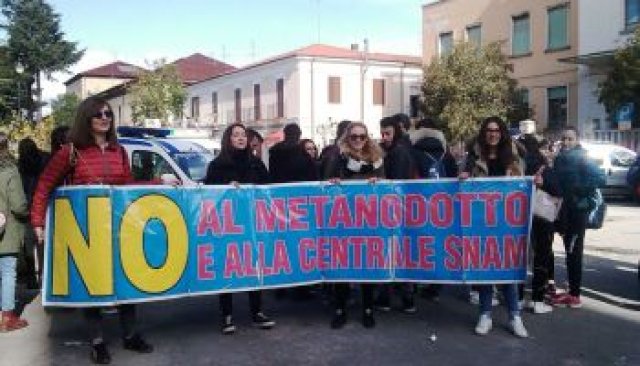
Snam Rete Gas, a leading Italian company in the transporting and dispatching of natural gases, announced in 2004 a planned pipeline extending from Massafra (Puglia) to Minerbio (Emilia-Romagna).
Named “The Adriatic Line” (in Italian: “Rete Adriatica”), it aims to export natural gases (methane, in this case) to Northern Europe. This project, which has been co-funded by the European Investment Bank, originally envisaged consolidating pre-existing structure all along the Adriatic Coast, thus limiting the environmental impact.
However, the methane pipeline has deviated from its planned path so that it passes through the Central Apennines, a mountainous area in central Italy — across the regions of Marche, Umbria, Lazio, Abruzzo and Molise.
This change has raised serious concerns for the environment and public health. Snam has responded with fictitious reasons for this project’s modification, but the truth is the company is simply aiming to significantly cut the pipeline’s construction costs.
Many environmental and left-wing groups, such as WWF Abruzzo and the Young Communists, have organised ongoing protests to stop the project. Many arguments have been raised in opposition to the pipeline’s construction.
First, the Central Apennines region is an area of high seismic risk, as recent events remind us. Last August, a 6.2 magnitude earthquake destroyed the town of Amatrice in Lazio. Then in October, a new shock registering 6.1 hitting the town of Visso in Marche, quickly followed by another earthquake registering 6.5 hit the towns of Norcia and Preci in Umbria. Finally, in January a violent earthquake affected the towns of Montereale, Capitignano and Campotosto in Abruzzo.
Consequently, experts say that placing a methane pipeline over several active seismic fault lines can have potentially disastrous effects on people and the environment. To make matters worse, a power plant is planned to be built in the town of Sulmona in Abruzzo, where the seismic risk factor is among the highest in the whole Central Apennines region.
Moreover, this project will have serious consequences for the environment, as it overlaps with a project (the “Apennines Park of Europe”) for environmental conservation in the same areas where the pipeline will be placed. It could also seriously damage the entire ecosystem.
The power plant’s emissions constitute a further risk to the environment and people’s health.
In the struggle against the methane pipeline, activists have left no stone unturned and have appealed both local and national institutions, as well as European ones.
This has achieved some results, delaying the realisation of this absurd project. In 2011, the Commission of the Italian Ministry of Environment ruled that the pipeline’s path must exclude the Central Apennines area, because of both the high seismic risk and the environmental costs that may come.
In 2015, the Italian Council of State proclaimed that, in this case, the precautionary principle should be applied, as the risks for public health, security and environment are not accurately known. This means that, being unable to predict the consequences of this project, the best course is to take no unnecessary risks.
Finally, Snam’s project was rejected both by the Regional Council of Abruzzo in 2015 and from other local town councils last year. However, from 2011 on, none of Italy’s successive governments have enforced any of these judgments. Instead former prime minister Matteo Renzi (in league with Abruzzo President Luciano D’Alfonso) repeatedly endorsed Snam’s project, including its deviation through the Central Apennines.
Why do Italian governments keep endorsing Snam’s project, ignoring both people’s opposition and the environment ministry and State Council rulings? What is the real reason Snam’s methane pipeline has to be built in spite of seismic risks, environmental protection and people’s health?
Currently, there is no way of knowing for sure the answers to these questions. What is certain is that both Italian governments and the European Union are continuing to support a project that is clearly unsafe and potentially dangerous — with no regard for people nor for parliamentary and local authorities’ activities.
Activists have not given up the struggle, and will continue to fight until Snam’s project is abandoned.
Like the article? Subscribe to Green Left now! You can also like us on Facebook and follow us on Twitter.